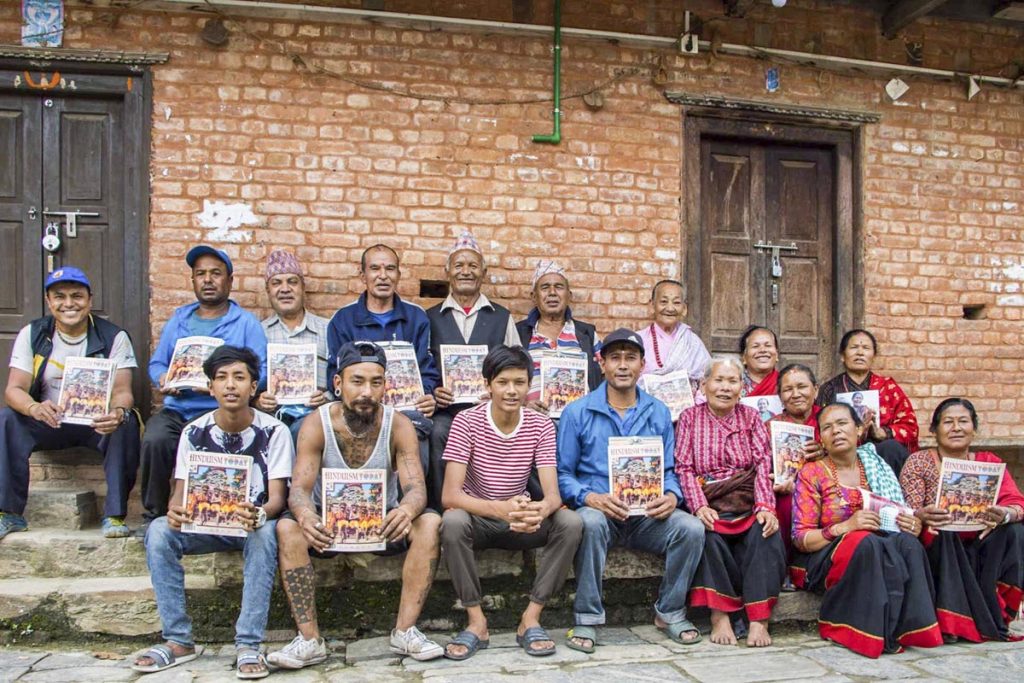Thank You from Nepal!
After six months, Rajeev and I returned to the Hanuman Ghat in Bhaktapur to distribute the Hinduism Today magazine copies to the Madhav Narayan Festival participants and committee members. Their happiness knew no bounds. (See photo at right.) They have asked me to impart a special thanks for the beautiful layout and for putting their beloved festival on the map in the feature “Nepal’s Grand Mela to Lord Vishnu” (Oct/Nov/Dec 2022). Dhanyabaad (thank you) from all of us! Madhav Narayan.


Nikki Thapa, author of the article
nikki@askmeaboutnepal.com
Through the Grand Mela article, I came to know that there is a Garura Vishnu Temple in Kathmandu at which my forefathers worshiped. As offspring, we have derailed from the old traditions for various political reasons since long centuries. I am from North Bengal, Lalmonirhat, Bangladesh. Next year I will visit this place.
Shashi Ray (Dilip)
omnamahvishnu2018@gmail.com
The Milk Miracle
In reference to “The Milk Miracle” (Nov. 1995), I am from Fiji and witnessed the miracle of Ganesha drinking milk. I was in year 11 in an Indian school at the time. The news of the milk miracle was spreading everywhere. Schoolteachers organized an event for 1,000 students to offer milk to Ganesha’s statue. We stood in a queue and took turns in pairs. One student offered milk with a spoon while the other stood and watched. My partner was Aiyaz, a Muslim boy. When it was our turn, he offered the milk and I watched. Slowly the milk disappeared from the spoon. I was amazed and will never forget that day. Was it surface tension or a miracle? If it was surface tension, it would still be happening today.
Alvin Singh
alvinksingh@gmail.com
Making Mandirs Great
Your article states exactly what I need at my age—in my forties! “Making Mandirs Cool Again” (Jul/Aug/Sep 2022) is engaging and relevant to my life growing up in the US. I need our temple in Oregon to be less intimidating and more accessible for myself and my children. What I want there is community, language classes, art, dance, performance, prayer, camp, fun activities and cooking. I think it can all be there. Right now I feel like I can’t participate, and there isn’t a place for me to belong in this city of a million people.
Sarika
principalmosley@gmail.com
Needed: Stories on Tolerance
I enjoyed reading “Tolerance: A Hindu Viewpoint” Apr/May/Jun 2022). As a teacher, am trying to find good religious stories demonstrating the values of tolerance in the face of prejudice and discrimination. I am using, for example, the Christian text the Good Samaritan. I would like to also use texts from other religions. I wonder if you might be able to suggest examples from the Hindu faith, ideally not too complex and with a clear message. Any help or advice will be much appreciated. Kind regards.
William Bryant
william@bryant.net
Pressure to Convert
I can relate well to the article “My Unfortunate Conversion” (Jul/Aug/Sep 2022). My journey started age seven in colonial Kenya when my father put me in the local mission school and I learned the Bible. At home my mom was a devout Hindu who spoke no English and prayed in Sanskrit. Today, via the Matha, I made my way to the Vedas, and I was “saved” from being converted.
Jayesh Patel
dumlers@yahoo.co.uk
To Divya ji, the author of the guest editorial “My Unfortunate Conversion,” thanks for sharing your journey. Reading of your experience is very valuable for anyone in the Hindu way of life, especially teens and young adults.
Praveen
potinenip@gmail.com
A Novel Map of the Mind
“The Mind’s Seven Dimensions” (Apr/May/Jun 2022) is a very interesting article. The framework presented is definitely helpful in elucidating the journey. Thanks!
Danesh
daneshthirukumaran@gm
One observation on the Seven Dimensions article: the word kaif» is repeated multiple times. Its probably a placeholder. Otherwise, the article is greatly informative. Thanks for sharing!
Mahesh M.
maheshmedisetti
√ Editor’s Note: Kaif» is a central concept in the Language of meditation, called Shum, created by Sivaya Subramuniyaswami. It means “awareness aware of itself and nothing else.” The term is discussed at some length in a sidebar within the article. Below are excerpts. The unusual character glyphs such as in the word im’° kaif» are diacritical marks specific to Shum.
“Anyone can experience kaif»—awareness aware of itself—for brief interludes. It is much more difficult to sustain the intensity, however, for the very power that allows us to control the mind enough to touch into kaif» stimulates the other dimensions as well, setting a wave rippling through stillest consciousness. That wave travels through the sixth, then the fifth, fourth and third dimensions, right out into the second. And if there are areas of the mind, especially in the second and third dimensions, which are not under guidance of the will or which are unresolved, then that ripple will catalyze them and pull awareness out of kaif». That is why very few aspirants are able to just sit in the absolute simplicity of kaif»—they are externalized by the outer dimensions as the intensity of pure awareness radiates and reverberates through the nerve complex. Therefore, although kaif» is itself easy to attain, it is indeed difficult to sustain for longer periods and even more difficult to dissolve into im’° kaif», Self Realization.” The aspirant, noting this, then dedicates himself to reining the outer manifestations of the second, third and fourth dimensions in order to gain a stable control over those forces…
Life’s Challenges
The Publisher’s Desk editorial “Life’s Challenges Are Not to Be Avoided” is a powerhouse. I keep going back to it again and again. It explains the true nature and blessing of challenges and the reasons we should embrace them fully; how true yoga is creating our future with care, the true perspective and appreciation for experiences in the world. All this is discussed. A masterpiece by a master.
Deva Seyon
devaseyon@gmail.com
Four Denominations of Hinduism
Congratulations to the Hindu brothers who carried out the wonderful explanatory work, “Hinduism’s Four Denominations” (Jul/Aug/Sep 2022). Namah Shivaya.
Shri Uberto Gama
mestrevidya@gmail.com
Navigating Today’s Challenging Times
How you can help our magazine continue providing spiritual tools for today
We asked our publisher, Satguru Bodhinatha Veylanswami, how he sees Hinduism Today’s role in these agitated times.
“The world is certainly going through a difficult period, right now,” he conceded. “We have lots of new opportunities to worry if we allow it, to become anxious, even fearful. Fortunately, Hinduism is there to remind us that, if left to themselves, these emotions can run wild. But they are ours to control, and Hinduism provides the knowledge and the practices to do so and turn the negatives into positives.
“We are encouraged to see the beginning of an inspiring trend where many Hindus, and others, especially the young, prefer to take personal inner responsibility for their spiritual unfoldment, as opposed to depending solely on outer affiliation or congregational participation. These are vital, too, but there needs to be a balance; we should not neglect personal self-effort.
“This reawakening to sadhana (regular practices done to enhance one’s spirituality) is promising. And our magazine is perfectly poised to help by continuing to highlight the philosophy, the vocabulary, the techniques and practices that best support individual striving.
“Pandit Vamadeva Shastri (Dr. David Frawley) praised Hinduism Today in our October-November-December 2020 issue for framing ancient Sanatana Dharma in fresh metaphors and language, making it available and appealing to contemporary minds. We have always strived to present Hinduism in a way that is usable in today’s world. Hinduism is ever a religion of today, helping us face issues of today and giving us tools for today, rather than dwelling heavily on history and the past.
“I would say that Hinduism Today is as relevant today at it has ever been, perhaps even more so. But it, too, has its challenges to face at this time, especially regarding fortifying its finances. Due to the pandemic, print sales are drastically down. It is fortunate that readers are turning to digital versions and overall readership is steady. But digital versions are of necessity free and cannot offset the drop in copy sales.”
Help our magazine to navigate today’s shifting currents, remain strong and be able to continue fulfilling its vital mission. We ask all who would support Hinduism Today to direct all gifts—yearly, monthly or occasional donations—to the Hinduism Today Current Expense Fund to meet day-to-day expenses:
Donate here, or contact us at: +1-888-464-1008 • support@hindu.org


